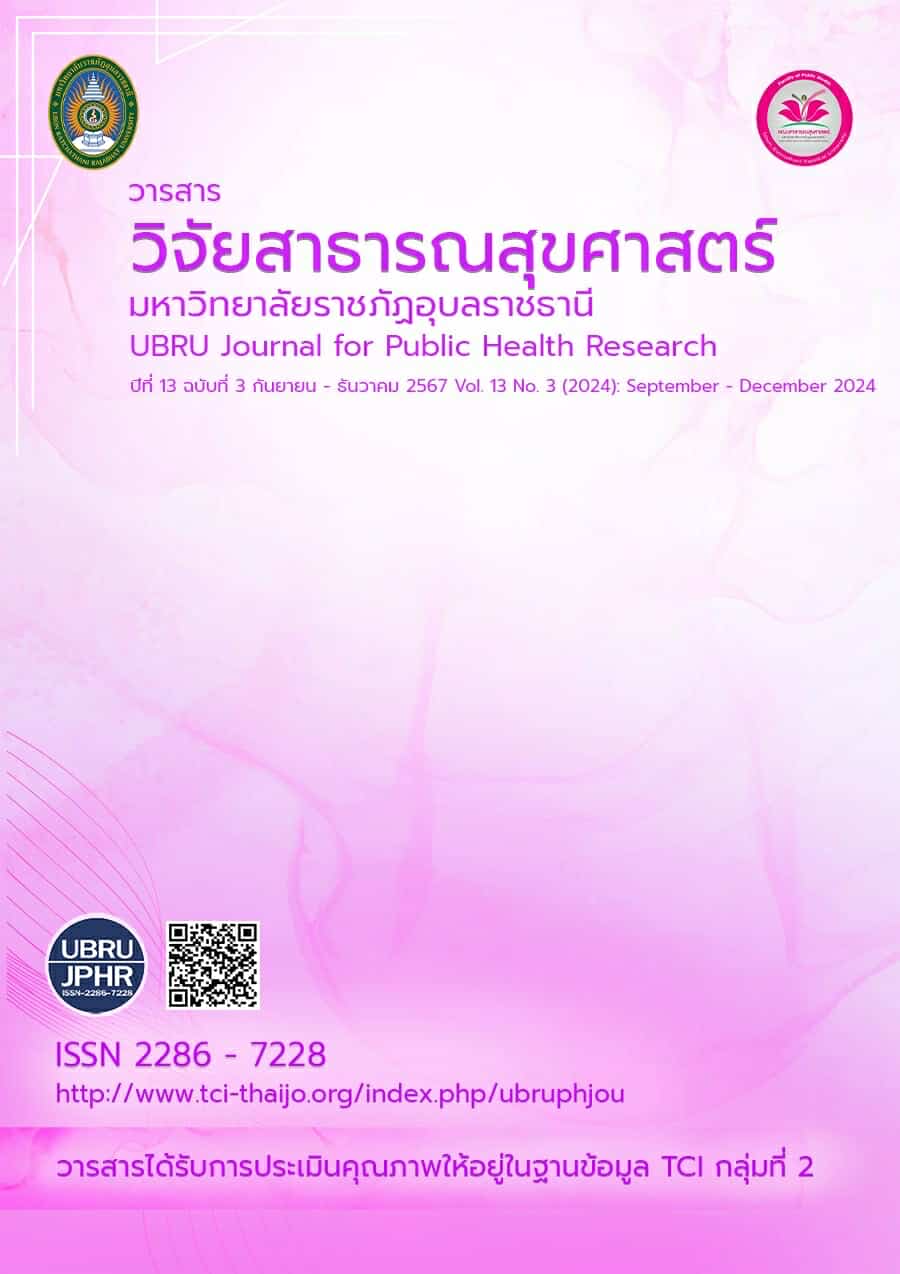ปัจจัยที่มีความสัมพันธ์กับพฤติกรรมการป้องกันการรับสัมผัสฟูมโลหะของพนักงานเชื่อมโลหะในบริษัทผลิตถังกลั่นน้ำมันแห่งหนึ่ง จังหวัดชลบุรี
คำสำคัญ:
ฟูมโลหะ, ความเชื่อด้านสุขภาพ, พฤติกรรมการป้องกันบทคัดย่อ
การวิจัยนี้เป็นการวิจัยเชิงพรรณนาแบบภาคตัดขวาง มีวัตถุประสงค์เพื่อศึกษาปัจจัยที่มีความสัมพันธ์กับพฤติกรรมการป้องกันการรับสัมผัสฟูมโลหะของพนักงานเชื่อมโลหะในบริษัทผลิตถังกลั่นน้ำมันแห่งหนึ่งในจังหวัดชลบุรี โดยใช้วิธีการสุ่มตัวอย่างแบบอย่างง่าย เก็บรวบรวมข้อมูลจากแบบสอบถามในกลุ่มตัวอย่างจำนวน 34 คน วิเคราะห์ข้อมูลโดยใช้สถิติเชิงพรรณนา ทดสอบความสัมพันธ์โดยใช้สถิติไคสแควร์และสถิติสหสัมพันธ์เพียร์สัน ที่ระดับความเชื่อมั่น 0.05
ผลการศึกษาพบว่า กลุ่มพนักงานส่วนใหญ่เป็นเพศชาย (ร้อยละ 73.5) มีอายุเฉลี่ย 41.18±10.684 ปี อยู่ระหว่าง 30-39 ปี ร้อยละ 32.4 ระดับการศึกษาประถมศึกษา ร้อยละ 26.5 อายุในการทำงานเฉลี่ย 10.86 ±9.75 ปี อยู่ในช่วงระหว่าง 11-15 ปี ร้อยละ 61.8 เป็นตำแหน่งที่มีการเชื่อม ร้อยละ 64.7 ระยะเวลาการทำงานเฉลี่ย 7.91± 0.379 ชั่วโมงต่อวัน ระดับความรู้เกี่ยวกับฟูมโลหะโดยภาพรวมอยู่ในระดับพอใช้ มีคะแนนเฉลี่ยร้อยละ 8.32 ±1.718 คะแนน ความเชื่อด้านสุขภาพด้านการรับรู้โอกาสเสี่ยง ด้านการรับรู้ความรุนแรง ด้านการรับรู้ประโยชน์ และด้านการรับรู้อุปสรรค ส่วนใหญ่อยู่ในระดับดีมาก มีคะแนนเฉลี่ยเป็น 11.56±2.427, 10.88±2.114, 13.71±1.426, และ 10.82±2.302 คะแนน ตามลำดับ และ พฤติกรรมการป้องกันการรับสัมผัสฟูมโลหะ ส่วนใหญ่อยู่ในระดับพอใช้ (32.97±7.903 คะแนน)
ตำแหน่งพนักงานเชื่อม การรับรู้โอกาสเสี่ยง และการรับรู้ความรุนแรง มีความสัมพันธ์กับพฤติกรรมการป้องกันการรับสัมผัสฟูมโลหะอย่างมีนัยสำคัญทางสถิติ (x2 = 9.632, r = 0.696, p < 0.01), (r = 0.751, p < 0.01) ดังนั้น ควรมีการส่งเสริมให้พนักงานมีการรับรู้ประโยชน์ของการสวมใส่อุปกรณ์ป้องกันส่วนบุคคลและควรมีมาตรการที่เหมาะสมเพื่อให้พนักงานมีพฤติกรรมการป้องกันการรับสัมผัสฟูมโลหะมากขึ้น
เอกสารอ้างอิง
ชนาพร เขื่อนเป๊ก และทัศน์พงษ์ ตันติปัญจพร. (2559). ปัจจัยทำนายพฤติกรรมการป้องกัน การสัมผัสมลพิษทางอากาศของผู้ประกอบอาชีพมอเตอร์ไซต์รับจ้างในเขตอำเภอแม่สอด จังหวัดตาก. วารสารความปลอดภัยและสุขภาพ. 9(33), 14-25.
โซเฟีย มะแซ, อัญชลี พงศ์เกษตร, ชมพูนุช สุภาพวานิช,จามรี สอนบุตร, และมะการิม ดารามะ. (2565). พฤติกรรมการป้องกันตนเองจากฝุ่นของคนงานในโรงงานแปรรูปไม้ยางพารา อำเภอนาทวี จังหวัดสงขลา. วารสารสาธารณสุขและวิทยาศาสตร์สุขภาพ. 5(2), 18-32
ดวงใจ วิชัย, ปัตพงษ์ เกษสมบูรณ์, และ ณัฐปคัลภ์ สันวิจิตร. (2561). พฤติกรรมเสี่ยงและปัจจัยที่มีความสัมพันธ์กับความเสี่ยงในการใช้สารเคมีกำจัดศัตรูพืชของเกษตรกร ในพื้นที่ต้นน้ำเขื่อนลำปะทาว จังหวัดชัยภูมิ. วารสารสำนักงานป้องกันควบคุมโรคที่ 7 ขอนแก่น. 25(2), 22-34.
ฟารอน หัตถประดิษฐ์,โสภา บุญละออ, และขนิษฐา อมประนาม. (2565). พฤติกรรมความปลอดภัยในการทำงานของพนักงานโรงงานไม้ยางพาราในจังหวัดนครศรีธรรมราช. วารสารวิชาการสาธารณสุข. 31(1), 27-35.
ภัครดา แสนสุขสม และ จงกล สังข์อ่วม (2562). การประเมินความเสี่ยงอันตรายของฟูมโลหะในกระบวนการเชื่อมที่ส่งผลต่อการปฏิบัติงานของคนงาน. วารสารวิชาการสถาบันเทคโนโลยีแห่งสุวรรณภูมิ. 2(6), 22–30.
มูลนิธิสัมมาอาชีวะ. (2562).พิษวิทยาอาชีพ.ค้นเมื่อ 20 ธันวาคม 2566. จาก URL https://safetyhubs.com/wp-content/uploads/2019/06/book_occtox.pdf
สมาคมอาชีวอนามัยและความปลอดภัยในการทำงาน. (2564). อันตรายของฟูมและอุปกรณ์ป้องกัน.ค้นเมื่อ 20 ธันวาคม 2566 จาก URL https://www.ohswa.or.th/17814732/he-morning-talk-by-occ-mahidol-ep6
สุนทร บุญบำเรอ. (2557). พฤติกรรมความปลอดภัยในการทำงานของพยาบาลในโรงพยาบาลมหาราชนครราชสีมา จังหวัดนครราชสีมา. วารสารวิทยาลัยพยาบาลบรมราชชนนี นครราชสีมา. 20(2), 82-92.
Bakri, S. F. Z., Hariri, A., & Ismail, M. (2019). Metal fumes toxicity and its association with lung health problems among welders in automotive industry. Journal of Physics: Conference Series, 1150(1), 012001. doi:10.1088/1742-6596/1150/1/012001.
Baloch, S., Kazi, T. G., Baig, J. A., Afridi, H. I., & Arain, M. B. (2020). Occupational exposure of lead and cadmium on adolescent and adult workers of battery recycling and welding workshops: Adverse impact on health. Science of The Total Environment, 720, 137549. https://doi.org/10.1016/j.scitotenv.2020.137549
Bloom, B.S. (1971). Handbook on formative and summative evaluation of student learning. New York : McGraw–Hill.
Falcone, L. M., Erdely, A., Kodali, V., Salmen, R., Battelli, L. A., Dodd, T., & Zeidler - Erdely, P. C. (2018). Inhalation of iron-abundant gas metal arc welding-mild steel fume promotes lung tumors in mice. Toxicology, 409, 24-32. https://doi.org/10.1016/j.tox.2018.07.007.
Firoozi Chahak, A., Fani, M. J., Alinaghi Langari, A. A., & Beheshti, M. H. (2018). Factors Affecting the Use of Respiratory Protection Devices Based on the Health Belief Model in Welders. Archives of Occupational Health, 2(1), 70-74.
Koh, D. H., Kim, J. I., Kim, K. H., & Yoo, S. W. (2015). Welding fume exposure and chronic obstructive pulmonary disease in welders. Occupational Medicine, 65(1), 72-77. doi:10.1093/occmed/kqu136.
Krejcie, R.V., & Morgan, D.W. (1970). Determining Sample Size for Research Activities. Educational and Psychological Measurement, 30, 607-610.
Nordberg, G.F., Akesson, A., Nogawa, K., & Nordberg, M. (2022). Chapter 7 Volume II Cadmium. In Handbook on the Toxicology of Metals, 5th ed.; Nordberg, G.F., Costa, M., Eds.; Elsevier: Amsterdam, The Netherlands; Academic Press: London, UK,141-196.
Racette, B. A., Searles Nielsen, S., Criswell, S. R., Sheppard, L., Seixas, N., Warden, M. N., & Checkoway, H. (2017). Dose-dependent progression of parkinsonism in Manganese exposed welders. Neurology, 88(4), 344-351. doi:10.1212/wnl.0000000000003533.
Rahul, M., Sivapirakasam, S. P., Vishnu, B. R., Balasubramanian, K. R., & Mohan, S. (2021). Health issue owing to exposure with welding fumes and their control strategies at the source-A review. Materials Today: Proceedings, 46, 9239-9245. https://doi.org/10.1016/j.matpr.2020.01.516.
Tagurum, Y., Gwomson, M., Yakubu, P., Igbita, J., Chingle, M., & Chirdan, O. (2018). Awareness of occupational hazards and utilization of PPE amongst welders in Jos metropolis, Nigeria. International Journal of Research in Medical Sciences, 6, 2227. doi:10.18203/2320-6012.ijrms20182808.
Thepaksorn P, Siriwong W, Neitzel RL, Somrongthong R, Techasrivichien T. (2018). Relationship between noise-related risk perception, knowledge, and the use of hearing protection devices among para rubber wood sawmill workers. Safety and Health at Work, 9:25-9.
ดาวน์โหลด
เผยแพร่แล้ว
รูปแบบการอ้างอิง
ฉบับ
ประเภทบทความ
สัญญาอนุญาต
ลิขสิทธิ์ (c) 2024 คณะสาธารณสุขศาสตร์ มหาวิทยาลัยราชภัฏอุบลราชธานี

อนุญาตภายใต้เงื่อนไข Creative Commons Attribution-NonCommercial-NoDerivatives 4.0 International License.
เนื้อหาและข้อมูลในบทความที่ลงตีพิมพ์ในวารสารวารสารวิจัยสาธารณสุขศาสตร์ มหาวิทยาลัยราชภัฏอุบลราชธานี ถือเป็นข้อคิดเห็นและความรับผิดชอบของผู้เขียนบทความโดยตรงซึ่งกองบรรณาธิการวารสาร ไม่จำเป็นต้องเห็นด้วย หรือร่วมรับผิดชอบใดๆ
บทความ ข้อมูล เนื้อหา รูปภาพ ฯลฯ ที่ได้รับการตีพิมพ์ในวารสารนี้ ถือเป็นลิขสิทธิ์ของวารสารฯ หากบุคคลหรือหน่วยงานใดต้องการนำทั้งหมดหรือส่วนหนึ่งส่วนใดไปเผยแพร่ต่อหรือเพื่อกระทำการใดๆ จะต้องได้รับอนุญาตเป็นลายลักอักษรณ์จากบรรณาธิการวารสารนี้ก่อนเท่านั้น


